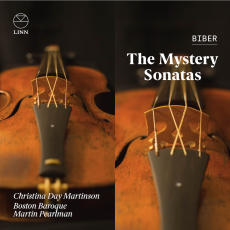Boston Baroque - Biber: The Mystery Sonatas - MusicWeb International
Heinrich Biber’s wonderful ‘Mystery’, or ‘Rosary’ Sonatas are rightly regarded as the Everest of the baroque violin canon. Time was when each new recording was an event; I had a quick look through the listings to see how many recordings there are by now, and gave up at 29. So this new set, featuring the estimable Canadian violinist Christina Day Martinson is entering a crowded market-place. She is accompanied on these two discs by a rather small-scale continuo provided by members of Boston Baroque, the group Martinson normally leads. This arrangement certainly leads the listener to focus their attention squarely on the violin playing, which may or may not be in the spirit of ‘authenticity’, or perhaps more in tune with these sonatas’ essential spiritual core.
In Biber’s instrumental masterpiece, the violin is tuned normally for the first sonata and the final, unaccompanied ‘Passacaglia’; by way of the device known as scordatura the strings are tuned differently (and more adventurously) for each successive sonata which largely accounts for the cycle’s legendary ‘difficulty tariff’. With this in mind Martinson took the decision to use six separate instruments to prevent the instability that inevitably affects a single violin with constant re-tuning. This was the practice adopted by these players in the many live performances of this cycle they produced in the months and years leading up to laying down these discs; listeners will have their own view as to whether this has any material impact on the sound of these readings.
There can be absolutely no doubt of these players’ absolute mastery of this cycle. Martinsson’s performance is fervent, sincere and profoundly skilled. At times the raw emotion transmits to the strings of her violin in such a way that one can imagine it bleeding. Some examples: The cumulative power of the fourth piece, ‘The Presentation of Jesus in the Temple’ is almost visceral in its impact. There is a more restrained power at work in the first of the ‘Sorrowful Mysteries’, ‘The Agony in the Garden’ where almost imperceptible strummings from the continuo punctuate the lamenting violin line; this is a deeply felt reading which at times betrays the real weirdness of Biber’s tunings. This contrasts with the following, seventh piece, ‘The Scourging of Jesus’ whose allemande displays a pleasing lightness.
By the time we get to final five ‘Glorious Mysteries’, the complexity of the tuning has reached its apogee. In the eleventh sonata, ‘The Resurrection’ the informative note in the booklet explains that “the middle two strings are crossed over each other both in the peg box and behind the bridge, so that one can literally see a cross on the violin”. This almost Cagean baroque conceit creates problems of balance for even the most experienced violinists, not to mention the stress placed on the instrument. With that in mind it is the only Sonata in this recording played on its ‘own’ instrument. Those rapid descending scales at the opening of this piece cannot be easy to play under these circumstances, but Martinson still delivers them with extraordinary deftness of touch. Eventually we reach the deeply affecting solo ‘Passacaglia’, sometimes referred to as ‘The Guardian Angel’, where normal tuning is restored and Martinson projects a real sense of return and repose.
Each sonata on this recording is prefaced by the sound of the four open strings re-tuned according to the needs of the particular piece – this certainly aids the listener in the task of finding their aural bearings. (Linn’s beautifully produced booklet even provides individual notations of these tunings) Martin Pearlman leads the fine continuo players in discreet, respectful accompaniment. But for this listener, alas, there is ultimately something missing in this recording. While I found the recorded sound rather dry and in-one’s-face, I imagine there will be others who feel that to be exactly the right ambience in which to best experience Biber’s extraordinary sequence. Yet I also felt a little emotionally disconnected from the proceedings despite what are self-evidently excellent performances.
I first got to know these pieces nearly thirty years ago when John Holloway’s wonderful Virgin (Warner/Virgin 5620622) recording landed in the shop where I worked and my boss put it on. It blew me away and until recently I thought it would never be equalled or surpassed. A few weeks ago I tuned into BBC Record Review’s ‘Building a Library’ segment. The subject was Corelli’s Violin Sonatas Op 5 and the recommended version sounded wonderful. It was that of the Spanish violinist Lina Tur Bonet and Musica Alchemica on Pan Classics, and I swiftly downloaded it. Further exploration eventually yielded her recent recording of these Biber Sonatas (PC10329). It is sublime and dramatic – it swings, it sings. The recording has a beautiful glow, the continuo is larger and projects a delightful array of ever varying colours. Whether Tur Bonet’s or Martinson’s approach is closer to Biber’s intentions is not the point for this listener, the former’s recording got completely under my skin in countless ways that eluded this Linn issue, fine though it is in its own way. As I said earlier – it’s a crowded marketplace.

